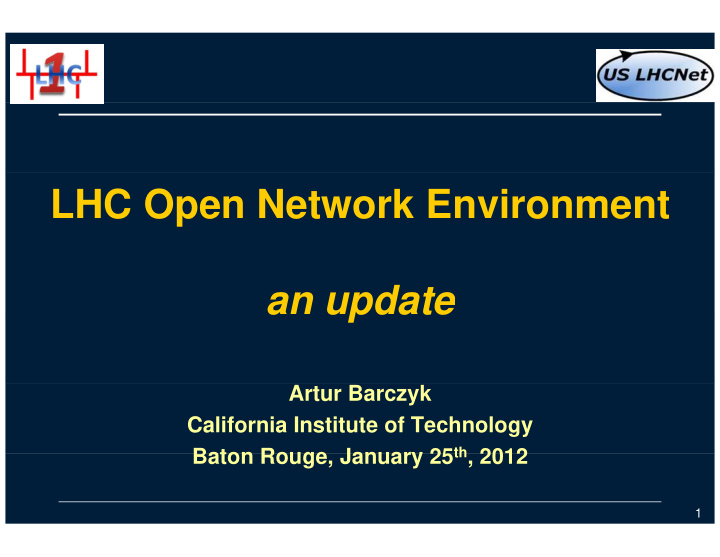



LHC Open Network Environment an update an update Artur Barczyk California Institute of Technology Baton Rouge January 25 th 2012 Baton Rouge, January 25 th , 2012 1
LHCONE: 1 slide refresher • In a nutshell, LHCONE was born (out the 2010 transatlantic workshop at CERN) to address two main issues: – To ensure that the services to the science community maintain their quality and reliability – To protect existing R&E infrastructures against the potential “threats” of very large data flows that look like ‘denial of service’ attacks l d t fl th t l k lik ‘d i l f i ’ tt k • LHCONE is expected to – Provide some guarantees of performance • Large data flows across managed bandwidth that would provide better determinism than shared IP networks • Segregation from competing traffic flows • Manage capacity as # sites x Max flow/site x # Flows increases – Provide ways for better utilisation of resources • Use all available resources, especially transatlantic p y • Provide Traffic Engineering and flow management capability – Leverage investments being made in advanced networking 2
So far,… • During 2011, LHCONE consisted of two implementations, each successful in its own scope: – Transatlantic Layer 2 domain • Aka vlan 3000, implemented by USLHCNet, SURFnet, Netherlight, Starlight – European VPLS domain • Mostly vlan 2000, implemented in RENATER, DFN, GARR, interconnected through GEANT backbone (DANTE) • In addition, Internet2 deployed a VPLS based pilot in the US • Problem: Connecting the VPLS domains at Layer 2 with other Problem: Connecting the VPLS domains at Layer 2 with other components of the LHCONE • The new multipoint architecture there foresees inter-domain connections at Layer 3 connections at Layer 3 3
4 LHCONE Layer 1 connectivity (Bill Johnston) sto ) Jo (
LHCONE Timescales • The WLCG has encouraged us to look a at longer-term perspective rather than rush in implementation • Pressure lowered by increase in backbone capacities and increased y p GPN transatlantic capacity – True in particular in US and Europe, but this should not lead us to forget that LHCONE is a global framework g • The large experiment data flows will continue to increase and alternatives to managing such flows are needed • LHC (short-term) time scale: – 2012: LHC run will continue until November – 2013-2014: LHC shutdown, restart late 2014 2013 2014 LHC h td t t l t 2014 – 2015: LHC data taking at full nominal energy (14 TeV) 5
LHCONE activities • With all the above in mind, the Amsterdam Architecture workshop (Dec. 2011) has defined 5 activities: 1. VRF-based multipoint service: a “quick-fix” to provide the multipoint LHCONE connectivity as needed in places 2. Layer 2 multipath: evaluate use of emerging standards like TRILL (IETF) or Shortest Path Bridging (SPB, IEEE 802.1aq) in WAN environment Sh t t P th B id i (SPB IEEE 802 1 ) i WAN i t 3. Openflow: There was wide agreement at the workshop that SDN is the probable candidate technology for the LHCONE in the long-term, however needs more investigations ho e er needs more in estigations 4. Point-to-point dynamic circuits pilot 5. Diagnostic Infrastructure: each site to have the ability to perform end-to-end performance tests with all other LHCONE sites d t d f t t ith ll th LHCONE it • Plus, overarching, 6. Investigate what impact (if any) will LHCONE have on the LHC software stacks and sites 6
7 Switched core, routed core,… take your pick VRF implementation M. Usman, DANTE
8 VRF implementation (II) D. Finkelson, Internet2
Milestones • Activities 2-4 are pilot and/or R&D • Based on the LHC schedule, we need to reach production-readiness by early-mid 2014 • Next LHCONE meeting in Berkeley, Jan. 30/31, 2012 g y, , (https://indico.cern.ch/conferenceDisplay.py?confId=160533) • Rough target milestones: – Jan 2012: VRF solution operational Jan 2012: VRF solution operational – Mid 2013-early 2014: phased migration from VRF – Late 2014: full production use • • Finer milestones: At the Berkeley meeting the activity leaders are Finer milestones: At the Berkeley meeting, the activity leaders are expected to report on timescales for their relative pilots – what can be achieved by – Mid 2013 Mid 2013 – Beginning 2014 9
10 (Shown only US portion of LHCONE) Phased transition from … E. Boyd, Internet2
11 (Shown only US portion of LHCONE) …to: E. Boyd, Internet2
Summary • LHCONE is pursuing dual strategy: – Implement a short-term solution, solving a subset of issues – Work on a long-term solution using new and leading edge developments in networking • It’s not too late for you to get involved • Next LHCONE meeting: Berkeley, Jan 30/31, 2012 Next LHCONE meeting: Berkeley, Jan 30/31, 2012 (Video conferencing in preparation, check out the meeting web site) • • Watch for updates: Watch for updates: http://lhcone.net http://lhcone net 12
13 THANK YOU! Artur.Barczyk@cern.ch t http://lhcone.net //lh htt
Recommend
More recommend